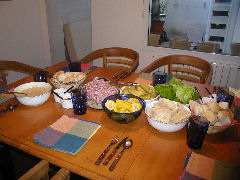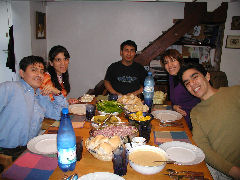Buenos Aires – It was a weekend of Andean cultural events for us. Saturday evening kicked it off with an outing to a peña in San Telmo. A peña is a sort of social hall type club. In this case, a group called Peña Jujeña Cumpas, rented out the basement of a catholic social center, charges admission, offers food and drink, and provides a band. Cumpas, is a term that is loosely defined as an extended family – the idea being that folk from the province of Jujuy, way up in the northwest in the mountains, who are here in Buenos Aires, need a regular place to network – connect up with old friends, meet new ones, share experiences, laugh, cry, get drunk together, dance together, sing together, whatever it may be. So once a week or so, this group rents a space and puts on some sort of event. We were invited by one of Henry’s schoolmates, who is from Jujuy, and thought we’d enjoy it. I didn’t take my camera with me, as I thought we were going to more of a club, but I was clearly the object of some amount of suspicion already, as one of the few white folk in the room, and an unknown one at that (plus sitting more or less by myself while Henry and the young lady who invited him danced – I’m going to have to learn a few folk dances so I can participate, otherwise these things get a little boring after about an hour), so snapping photos probably wouldn’t have gone over well.
For an hour or two everyone hung out, eating tamales, empanadas, and locro, and drinking beer and wine by the liter. Around two hours into it, the band for the evening arrived, got tuned up, and started to play. Initially a tentative response, with the first few songs only drawing a few couples out onto the dance floor – traditional dances of the region, though notedly, everyone seems to have their own version of how to perform many of these dances, something that initially I found unusual for folklore dance, which I’m used to being pretty well defined, but as Henry pointed out, many of these regions have what amount to different “tribal” customs, because many of the pueblos in the mountains developed them differently over time, with little contact between each other. By the third or fourth dance, the floor was packed. There was a mix of very individualistic folk, who stuck with their partner, dancing in their own space, and spontaneously formed group dances – more or less line dancing, that happened as well. Of interesting note, something that definitely surprised me, the concession stand was also selling bags of coca leaves, and as the evening wore on, the dancers, especially the guys, were breaking out the bags (1 peso for about 2 ounces), and popping the leaves – a bit of stimulation to keep going as they got tired.
 Sunday, after a late night on Saturday, had us up fairly early, as Henry had invited friends over for a cebichada, or ceviche “dinner party”. Ceviche, as I’ve come to find out, is not one of the easier dishes to prepare, especially if you want to prepare it well. There was fish to cut, lemons to squeeze, and marinating to perform. Batatas and mandiocas needed to be peeled, cut, and boiled separately (although, I’m now informed, after once again having done it wrong, that batatas should be cooked whole, then peeled and cut afterwards, and mandiocas need to be scrubbed with steel wool after peeling to remove a thin fibrous layer). Red onions and hot peppers need to be sliced, garlic, ginger, and cilantro to be chopped. But a cebichada doesn’t stop with ceviche, it merely has that as its core. So potatoes needed halving and boiling (once again, to be peeled and sliced after cooking),
Sunday, after a late night on Saturday, had us up fairly early, as Henry had invited friends over for a cebichada, or ceviche “dinner party”. Ceviche, as I’ve come to find out, is not one of the easier dishes to prepare, especially if you want to prepare it well. There was fish to cut, lemons to squeeze, and marinating to perform. Batatas and mandiocas needed to be peeled, cut, and boiled separately (although, I’m now informed, after once again having done it wrong, that batatas should be cooked whole, then peeled and cut afterwards, and mandiocas need to be scrubbed with steel wool after peeling to remove a thin fibrous layer). Red onions and hot peppers need to be sliced, garlic, ginger, and cilantro to be chopped. But a cebichada doesn’t stop with ceviche, it merely has that as its core. So potatoes needed halving and boiling (once again, to be peeled and sliced after cooking),  a huancaina sauce needed to be made (puree of crackers, milk, cheese, reconstituted dried ají panca amarilla, salt, and pepper), olives pitted and sliced, eggs boiled and sliced – all that for the accompanying papas a la huancaina. And, of course, despite the fact that all that was enough food to feed a dozen people for a day, and we were only six for lunch, we needed to have pollo con tallarines, chicken and noodles – the former marinated in a mix of salt, pepper, cumin, pureed ají panca roja, and red wine for a couple of hours, then stewed in its marinade, along with the addition of several finely grated carrots and a large handful of bay leaves, then the sauce poured over the noodles which are served under the stewed chicken. Two of the guests brought a tray of masas, small little pastries to go with coffee, tea, and/or mate after the meal, and the other two brought a large torta de ricotta, so that needed to be sliced into small wedges and eaten as well, or at least as much of it as anyone could manage at that point. All excellent, and we have food left for several days, though I watched amazed at the quantity packed away by these folk. You’d think they hadn’t eaten in weeks, or were fairly certain they weren’t likely to eat again in the near future.
a huancaina sauce needed to be made (puree of crackers, milk, cheese, reconstituted dried ají panca amarilla, salt, and pepper), olives pitted and sliced, eggs boiled and sliced – all that for the accompanying papas a la huancaina. And, of course, despite the fact that all that was enough food to feed a dozen people for a day, and we were only six for lunch, we needed to have pollo con tallarines, chicken and noodles – the former marinated in a mix of salt, pepper, cumin, pureed ají panca roja, and red wine for a couple of hours, then stewed in its marinade, along with the addition of several finely grated carrots and a large handful of bay leaves, then the sauce poured over the noodles which are served under the stewed chicken. Two of the guests brought a tray of masas, small little pastries to go with coffee, tea, and/or mate after the meal, and the other two brought a large torta de ricotta, so that needed to be sliced into small wedges and eaten as well, or at least as much of it as anyone could manage at that point. All excellent, and we have food left for several days, though I watched amazed at the quantity packed away by these folk. You’d think they hadn’t eaten in weeks, or were fairly certain they weren’t likely to eat again in the near future.
[…] The menu began with an upscale ceviche. The “height” of fish in Peruvian ceviche is apparently the lenguado, which is a catchall name for various flatfish – plaice, sole, flounder, fluke. So we took a kilo of that, and half kilo each of fresh shrimp and squid (these get cooked first, before being added to the lemon juice, I’m not sure if that’s always the case in Peruvian tradition, but I know Henry always cooks shellfish that go into ceviche, insisting that you can’t “cook” them via the ceviche technique – though I’ve certainly had many ceviches in other parts of the world that used raw shellfish). I’ve covered his ceviche making in another post, so I won’t go into detail here. […]